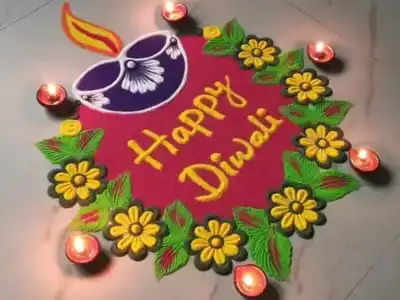Top 8 Rangoli Designs For Diwali

Diwali is largely observed to honour the arrival of the goddess Lakshmi. Prayers are made to her in order to obtain financial benefits from her. Diwali's origins and significance may be traced to the triumph of good over evil, knowledge over ignorance, joy over sorrow, and light over darkness that it represents. Every year, people prepare delicious foods, don new clothes, decorate their homes, give out sweets, and create rangolis to further enhance the celebration of the Diwali festival. As a result, a Rangoli pattern is made at the front door of the house to welcome both the Goddess and any visitors.

Diwali is a festival that marks the victory of good over evil and is celebrated with immense joy and enthusiasm. It is believed to be the day that the Goddess Lakshmi descended from the heavens to bless us with wealth and prosperity. People pray to her to bring them luck and a fruitful life. Every year, people take the opportunity to celebrate Diwali with great zeal, by preparing mouth-watering delicacies, wearing beautiful clothes, decorating their homes, and exchanging sweets. One of the most important aspects of Diwali is the Rangoli design that marks the entrance of every house. Rangoli is made using colored chalk, rice powder, and crushed limestone, and is a beautiful way to welcome the Goddess and the guests into one's home. It is a stunning display of culture, art, and tradition that sets the mood for the festivities of Diwali.

Diwali is a time of joy and celebration, and it is a time to welcome Goddess Lakshmi into our homes. One of the most beautiful ways to do this is to create a rangoli at the entrance of the house. Rangoli, with its intricate designs and mesmerizing colours, is believed to bring positive energy and ward off negative energy. It is also bordered with a lotus design, as a gesture to welcome Goddess Lakshmi.

Rangoli designs are complex and detailed, since it is believed that the complexity of the design traps any negativity around us and stops it from entering the house. This Diwali, why not try your hand at making a rangoli of your own? You can take inspiration from traditional designs, or come up with something creative and unique. It is also a great way to bond with family and friends, and is a great way to get into the festive spirit. So this Diwali, make a rangoli and welcome the positive energy into your home!

Rangoli is an art form that has no limits to its size. Most commonly, it is seen as a doormat placed at the entrance of a home, but for those that have the space, the possibilities for this type of artistry are endless. In larger homes, such as bungalows, it is not uncommon to see an entire courtyard filled with a beautifully crafted Rangoli.

The patterns and difficulty of a Rangoli depend largely on the talent and skill of the person making it. This type of art is always done by hand and requires a great deal of concentration and patience. The lines are usually drawn using a single finger, much like a pencil would be used to draw on paper. In some cases, a pattern may be outlined using a series of dots that are then joined together at the end. Once the pattern is formed, the desired colors are filled in.

Rangoli is an artistic expression that can inspire and delight those who observe it. Whether it is a small doormat or a large courtyard filled with intricate patterns, the possibilities are endless and each piece is unique. It is a wonderful way to express creativity and an excellent way to bring a little bit of color and cheer into any home.When it comes to worshipping the Goddess Lakshmi, one of the most creative ways to show reverence is through incorporating symbols and elements associated with the Goddess into the design of the puja room.

Myths say that the Goddess used to sit on a lotus flower, so many devotees add petals on the border of the design. This is just one of the many ways that worshippers get creative in their offerings to the Goddess. Other popular symbols include coins, which represent abundance and prosperity, and mango leaves, which represent fertility and growth. People also like to incorporate items such as diyas, bells, and images of the Goddess to create a more immersive experience. By including these symbols in their puja room design, devotees demonstrate their deep devotion to the Goddess.


